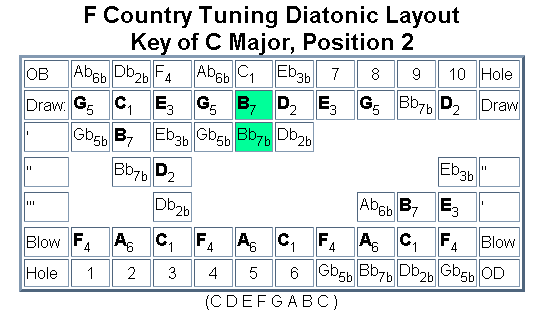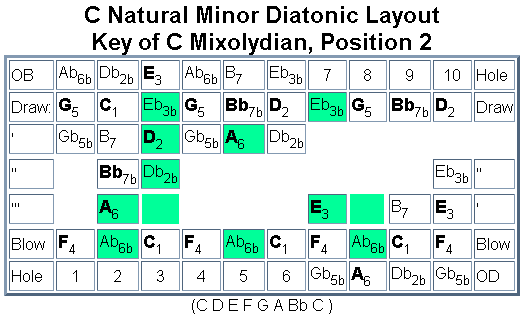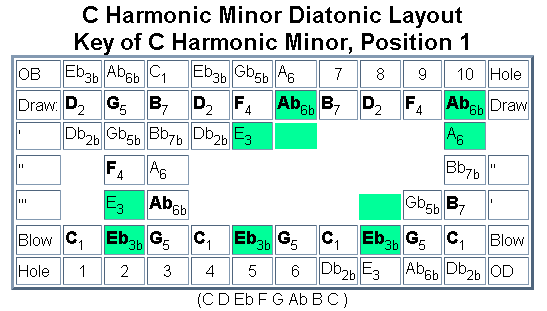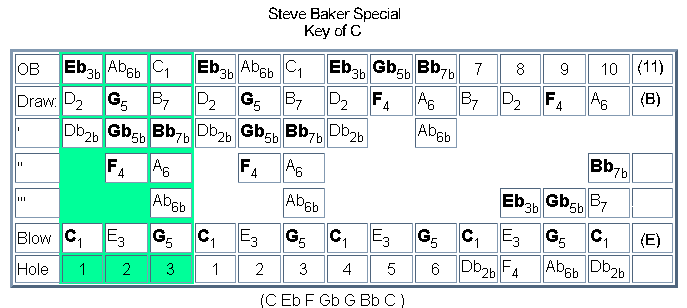Special Tunings
Harmonicas with special tunings have reeds that have been tuned
differently from the standard for that instrument, e.g. Richter major diatonic
tunings for diatonic harps, and solo tuning for chromatics. There
are a few common special tunings for the diatonic harp, and hundreds of
rare ones have been designed. (See Pat Missin's comprehensive collection
of special tunings in his "Altered States" document at http://www.users.globalnet.co.uk/~patm).
Special tunings offer different natural notes (unbent blows and/or draws)
from the standard tuning. These different natural notes create
different chords, and can be beneficial for playing songs or melodies
that need the new note more than the one it replaced, and suffer from producing
the note via bends or overbends. Special tunings differ from the
standard tuning by as little as one note (e.g. the country tuning) and
as many as all of them! (Some players, for example, tune a normal
C harp up to a standard D tuning.) Since the available bends and
overbends depend on the pitches of the natural notes in the hole, special
tunings have different bending capabilities and bend notes than the standard
tuning, in addition to different natural notes.
The best bet is to try some of these special tunings to hear their characteristics
sounds and feel their different playing characteristics. These tunings
can bring new music into your repertoire and help bust you out of playing
ruts, since your same ol' licks will sound new and fresh with the different
notes and chords.
Country Tuning
The country tuning, also called the "jazz" tuning for Huang brand harps,
is the simplest and one of the most common special tunings. The only
difference from a standard Richter major diatonic tuning is that the
hole 5 draw note is raised a semitone--e.g. from a Bb to a B on
an F harp, or F to F# on a C harp, that's it, just one reed is tuned differently.
This is very useful in many songs whose melodies use the major 7 note of
the root chord in second position--e.g. C on an F harp, or G on a C harp.
On a standard tuning, that note requires an overblow on hole 5, which is
not a simple note to play well. Further, many such songs are harmonized
with a Major 7 root chord rather than a dominant 7 chord found on the standard
tuning (e.g. CMaj7 instead of C7), and that chord change occurs as well--the
second position root chord becomes a Maj7 instead of a 7 chord. In
addition, the V chord for 2nd position (G in key of C) is now major instead
of minor, changing the feel of the 4/5/6 draw chord as well as the 2/3/4/5
draw chord.
The effect of raising the pitch of the 5 draw a half step is to add
a draw bend to hole 5--on a normal tuning the hole 5 draw bend is less
than a full semitone (i.e. "missing")--which is the same note as the natural
hole 5 draw on a standard tuning. In other words, you don't lose
that note because you raise the pitch of its reed a half step--it just
moves to a new bend in hole 5' that is easy to hit (i.e. it's not a "fretless"
bend like 2' or 3"). Here's the layout for second position key of
C with the country tuning changes highlighted:

Melody Maker(TM) Tuning (Lee Oskar(TM)
Harmonicas)
The Melody Maker tuning takes the country tuning one step farther and changes
the pitch of 3 reeds from the standard tuning. In addition to raising
hole 5 draw a half step to the major 7 note of the 2nd position scale,
e.g. Bb to B on a key of C Melody Maker (which are labeled based on 2nd
position), it also raises the octave of the 5 draw, the 9 draw, a half
step from Bb to B on a C Melody Maker. So both the
5 draw and the 9 draw are raised a half step. In addition,
the pitch of the hole 3 blow is raised a whole step. This means the
hole 3 blow is no longer the same note as the hole 2 draw. You lose
the corresponding 2 bend notes for the hole 3 draw, i.e. the whole step
and step-and-a-half bends (D and Db for 2nd position C). Note that
this also pushes the Db from a bend in hole 3 to an overblow in hole 2,
and the Bb from a bend in hole 9 to an overblow on hole 8. The blow
chords on the low end of the harp change as you get a 6th flavor in blow
1/2/3 (e.g. F/A/D), and a minor chord in 3/4/5 (e.g. D/F/A). Along
with the Maj7 for the root chord (instead of dominant 7), and 2 major
V chords (insteand of minor) at 4/5/6 and 8/9/10, the chordal feel of this
tuning is quite different from a standard tuning, perhaps more "pop" sounding
than a standard tuning which works better for blues and rock feel.
Here's a key of C diagram with the differences highlighted:

Natural Minor Tuning
The natural minor tuning (or essentially similar dorian minor "mol n" tuning)
changes the character of the diatonic, as its name implies, from a major
feel to a minor feel. Five reeds have their notes changed: the blow
2, 5, and 7 notes are flatted a half step, e.g. from A to Ab on a 2nd position
C tuning, and the draw 3 and 7 notes are also flatted a half step, e.g.
from E to Eb on a 2nd position C tuning. The bends and overblows
change according to the changes of these natural notes. In first
position the natural mode is a dorian minor, while in second
position the natural mode is a natural minor. The blow chords,
which are major on a standard tuning, are minor (flat third) in this tuning,
and the normally major draw chord in (1)/2/3/4 is now also a minor chord.
This minor 3rd of the 2nd position scale is a primary "blue" note often
used in blues (but in blues the note is often between a major and a minor
third, not bent all the way flat). Many minor key songs lay out more
naturally on a natural minor tuning than on a standard Richter major tuning.

Harmonic Minor Tuning
The harmonic minor tuning has a harmonic minor scale as the natural mode
of first position play. As in the natural minor tuning, 5 reeds have
changed notes: the musical 3rds are flatted by lowering blow notes in holes
2, 5, and 8 a half step and the draw notes in holes 6 and 10 are also lowered
a half step to provide the flat 6th for the harmonic minor scale.

Steve Baker Special
The Steve Baker Special (SBS) is both a special tuning and a special harp--14
holes instead of 10, but the very top hole is "extra" and not really part
of the tuning. The Steve Baker Special basically just duplicates
the first 3 holes of a standard tuning as the first 3 holes of the SBS,
and keeps the rest the same. For keys above A, the bottom 3 holes
are an octave lower than a standard tuning. This tuning provides
an extra set of good bending draw reeds for blues, and is particularly
good for vamping chords on the low end while mixing in melody above.
Here is a look at a key of C SBS tuning:

Hohner 365
The Hohner 365 is another 14 hole diatonic harp. It is similar to
the Steve Baker Special only instead of duplicating the first 3 holes as
the lower octave, the Richter major diatonic pattern is held consistent
as 4 more holes are added to the high end of a standard Richter major diatonic
layout. This means that the bottom 10 holes are like a "tenor"
or low tuned standard diatonic, and the high 4 holes are "all messed up",
but add interesting possibilities, especially for blow bends. Here
are holes 11-14 on a Hohner 365:
| Hole |
11 |
12 |
13 |
14 |
| Draw |
B |
D |
F |
A |
| Blow |
E |
G |
C |
E |
Hohner 365
Combination Tuning
Invented by Winslow Yerxa (as far as I know), this tuning provides a combination
of seconnd position (low end) and first position (high end) bends to try
to optimize the harp for playing blues. Here's how it looks:

Other Tunings
There are other special tunings commercially available, or able to be produced
by you or your favorite harp technician.
Some harmonica companies (e.g. Hering and Suzuki) will even make harps
tuned to your specification for an extra charge. These include the
Spanish tuning, spiral tuning, and various layouts based on whole tones
(augmented triads) that provide full chromatic capabilities to the diatonic
harp by using only normal bends, with no overbends or valved bends required.
These are used much less frequently than the above, usually for special
songs or playing requirements, or just to explore the capabilities of the
harp. Amazingly enough, since the Richter layout was not designed
with bends and overblows in mind, none of these exotic tunings or even
the normal special tunings, has superior general applicability to the Richter
major tuning to displace it as the tuning of choice for the vast majority
of players. As overblows become more accessible to a wider range
of players, the biggest advantages of special tunings is in their chordal
capabilities for certain songs and styles of music.
Magic Dick Tunings
The famous harp player for the J. Geils band, "Magic" Dick, has worked
with Pierre Beaurigard to patent the whole range of diatonic tunings where
the blow note is always lower than the draw note, and all bends are draw
bends. Some of these tunings should become commercially available
in the forseeable future. Companies that offer custom special tunings
may be resistent to the potential of infringing on this patent.






